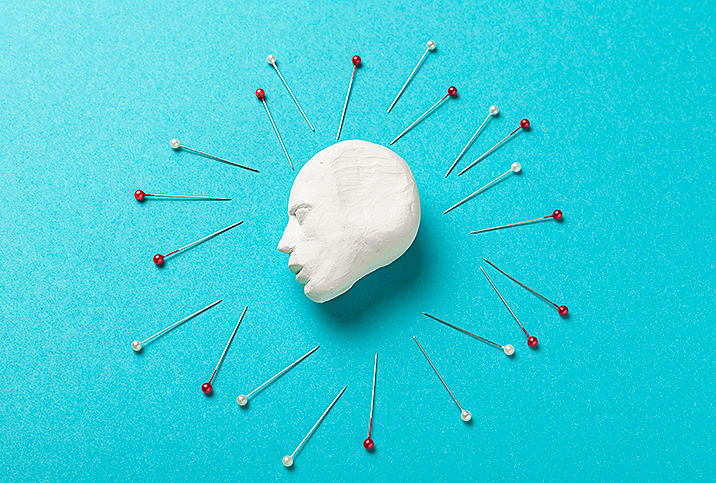Migraine or Headache? Here's How to Tell the Difference

Tell me if this sounds familiar: You're sitting in front of your computer and, suddenly, your vision goes blurry and spots appear along the edges of your field of vision. A subtle throbbing begins on one side of your head and you feel a headache coming on. In search of a remedy, you take an over-the-counter pain medication and lie down in your bedroom, shades drawn, with a damp washcloth resting on your forehead. You have work to do but know you need to sleep this thing off.
Or maybe there are no spots. Maybe your headache sneaks up out of nowhere, intense and pounding, accompanied by intense nausea. You retreat to your bedroom, a sleep mask over your eyes. It's only the early evening, but you don't emerge again until morning, aside from one or two trips to the bathroom to vomit.
Perhaps these symptoms were caused by sinus pressure or you self-diagnose a tension headache. However, there's a good chance you were experiencing a migraine disorder.
As you might predict, the majority of people experiencing a migraine don't place sexual activity high on their to-do list. However, in a research study published in 2013 surveying 1,000 patients who experienced migraines, 34 percent were familiar with having sex during a migraine and 60 percent of these people reported an improvement in their attack.
There is a theory that sexual activity simply provides enough distraction to relax someone from the symptoms of a migraine. There is also speculation that endorphins released during sex and an orgasm may help relieve the pain of a migraine. However, since sex requires physical involvement, a migraine may be exacerbated by pressure on the back and neck. Additionally, there's an increase in blood pressure that can also trigger symptoms.
What is migraine disorder?
When folks think about "migraines," they typically equate them with headaches. But as explained by Lauren R. Natbony, M.D., medical director of Integrative Headache Medicine of New York and an assistant professor of neurology at the Icahn School of Medicine at Mount Sinai, the truth is that headaches—a term for general head pain—actually can be a symptom of a chronic and debilitating neurological disease that affects how the brain processes pain.
One of the primary genetic headache disorders—meaning it can be inherited and run in the family—is migraine episodes, which can range in severity from moderate to severe.
Migraine symptoms and stages
A migraine headache typically presents with moderate to severe pain on one side of the head that is throbbing or pounding. This pain is often made worse by movement and can last for more than four hours, Natbony explained.
Other migraine symptoms include:
- Nausea
- Sensitivity to light, sound or odors
- Spots or flashing lights in sufferers' vision
- Vomiting
A migraine episode can have as many as four stages, though not everyone who experiences a migraine goes through all of them.
1. Prodrome
The first stage of migraine, prodrome, can occur anywhere from hours to days before the onset of a headache. Symptoms can include:
- Constipation
- Fatigue
- Fluid retention
- Food cravings
- Frequent yawning
- Increased urination
- Mood changes, from depression to euphoria
- Neck stiffness
2. Aura
Migraine comes in two flavors: with aura and without. Folks often assume all migraine episodes involve aura, which is just another reason they remain severely underdiagnosed. Only 30 percent of people with migraine experience an aura.
For people who experience an aura, it acts as a warning sign of what's to come. An aura can include visual disturbances—such as flashes of light or black spots—or other intrusive physical reactions, such as a tingling or numbness along one side of the body or slurred speech.
According to Natbony, this phase can last anywhere from five to 60 minutes.
3. Attack
An attack is the main event and usually lasts from four to 72 hours if untreated.
During a migraine, you might have:
- Blurry vision
- Dizziness
- Nausea and vomiting
- Pain that throbs or pulses
- Pain, usually on one side of your head, but sometimes on both sides
- Sensitivity to light, sound and sometimes aromas and touch
4. Postdrome
The last stage, postdrome, is experienced by about 80 percent of sufferers. Natbony said symptoms can mimic ones from the prodrome stage and last up to 48 hours. Some people report feeling drained and confused, while others report a feeling of elation.
Migraine triggers
Natbony explained that the top three migraine triggers are stress, hormonal fluctuations and barometric pressure changes.
"The migraine brain hates change," she said. "Its response is to inappropriately trigger pain."
In the case of stress or a stress letdown, one of the most frequently reported triggers—by 70 percent to 80 percent of people with migraines—is a change in brain chemicals that makes the brain more likely to release pain signals in people predisposed to migraines.
When it comes to shifting hormones, female hormones (primarily estrogen) are the culprit and may be the reason migraine disorder is more prevalent for women. Natbony explained that estrogen levels rise during the first half of a woman's menstrual cycle and drop rapidly leading up to menstruation. This rapid decline is thought to trigger the release of neurochemicals that can lead to a migraine attack.
As for barometric pressure changes, a change in atmospheric pressure can create an imbalance in the pressure within the sinus cavities and the structures and chambers of the inner ear, which can then result in pain.
However, there are other triggers, too, noted Susan Broner, M.D., an assistant professor of clinical neurology at Weill Cornell Medical College in New York City and the medical director of the Weill Cornell Medicine Headache Program. Products and other factors such as monosodium glutamate (MSG), artificial sweeteners, cured meats, aged cheeses, wine, dark alcohols, lack of sleep, dehydration and too much caffeine can all contribute to triggering a migraine episode.
Common migraine myths and misconceptions
Possibly the most common misconception about migraine disorder is that it's "just" a headache. As previously mentioned, it's a chronic neurological disease in which headaches are but a single symptom.
The commonality of migraines is another misconception that permeates. Many folks who experience mild migraine attacks, particularly ones without aura, assume they're struggling with another type of headache entirely. But there are subtle differences between migraine and other headache disorders.
In the case of a tension headache, for example, headache symptoms are milder than the ones that adjoin a migraine and they don't worsen with activity. While migraine-related headache pain typically occurs on one side of the head, tension headaches cause pain that persists on both sides of the head. Tension headaches may also cause light or sound sensitivity, but never both, and they never cause nausea or vomiting.
Then there's the sinus headache, another common scapegoat. But sinus headaches are often accompanied by infectious-looking mucus and fever, symptoms rarely seen with migraines.
Don't have a doctor you see regularly? You should. Fortunately, telehealth makes it easy to connect with a doctor who can answer your questions and evaluate your condition. Many physicians offer video visits, which are a good way to see a doctor quickly since a lot of them have same-day appointments. Giddy telehealth is an easy-to-use online portal that provides access to hundreds of healthcare professionals whose expertise covers the full scope of medical care.


















